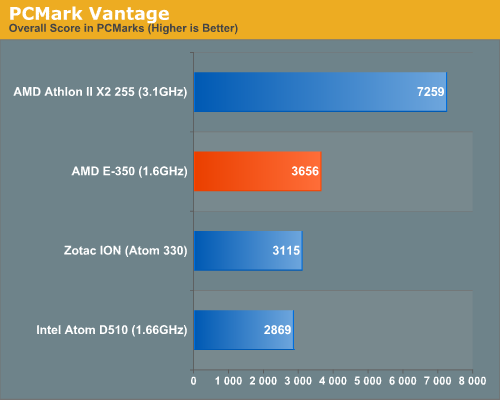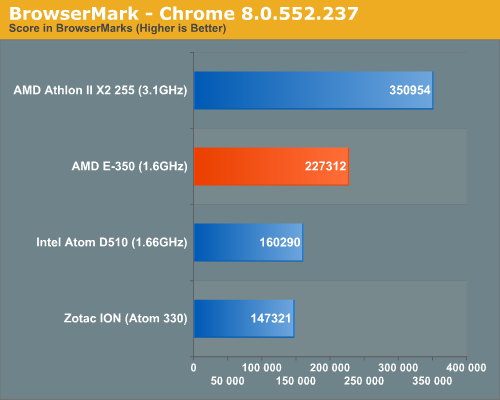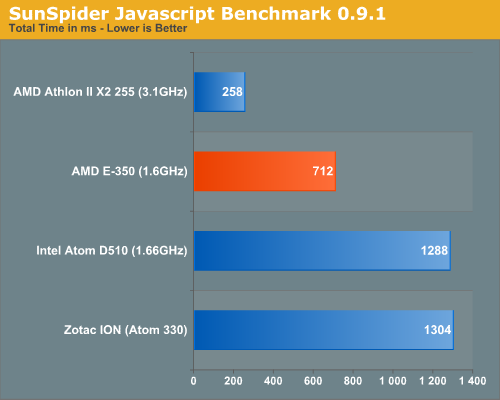The Brazos Review: AMD's E-350 Supplants ION for mini-ITX
by Anand Lal Shimpi on January 27, 2011 6:08 PM ESTGeneral Performance: In Between Atom and Athlon II
Atom may be efficient and fast enough to run a smartphone OS, but it absolutely chugs on Windows 7. The seat of the pants feel of an AMD E-350 is noticeably better. Single threaded performance, as you’ll soon see, is easily twice that of a similarly clocked Atom. Bobcat is still a dual-issue dual-core machine so high IPC or highly threaded workloads will show little difference between it and Atom. Thankfully, for most entry level netbook/nettop workloads Bobcat’s architecture should be sufficient. Before we get to the more CPU intensive tests I wanted to run through some reader requests for performance characterization.
I’ll start out with PCMark Vantage. There’s very little that separates PCMark from SYSMark in terms of how realistic the workload is. Neither suite is particularly representative of what an average user does today. What these suites are good at is being very long, and stressing enough aspects of a platform to give you a general idea of performance. SYSMark tends to focus on the more heavy user/content creation side of things (optimized for no more than 2 cores), while PCMark Vantage is much lighter test.
Looking at SYSMark you’d see no performance difference between the E-350 and Atom. The reason is simple. SYSMark was designed to be a modern day CPU benchmark. Most of the workloads exhibit high IPC and thus Bobcat’s front end acts as a bottleneck.
While SYSMark can be useful in estimating how a processor might handle particular heavy workload, it’s not useful in characterizing the sort of light workloads that you’d see a netbook or nettop user creating. PCMark Vantage is a collection of far simpler tasks. Again not specifically what you’d do today, but lighter nevertheless.
I compared four systems using PCMark Vantage, all with the same memory and I/O configuration. I dusted off an Atom 330 + ION motherboard from Zotac, an Atom D510, the MSI E-350 board and an Athlon II X2 255 on an 890GX motherboard. I picked the Athlon II simply because it’s a very affordable (~$65) modern day dual-core CPU. The Athlon II will help put the E-350’s performance compared to modern day x86 cores in perspective.

The E-350 holds a clear advantage over the Atom D510. The overall suite runs 27% faster on the E-350 than the D510, and even 17% faster than ION (the overall suite includes some GPU tests where ION makes up for Atom). The advantages vary from 10 - 80% in most cases. If you look at tests where the GPU is involved, you have to start counting how many times Brazos is faster than Intel’s current Atom platform.
I have to put the E-350’s dominance in perspective however. An Athlon II X2 255 still delivers nearly 2x the performance of the E-350 in PCMark Vantage. Just as the Atom to E-350 jump is noticeable, so is the jump from an E-350 to an Athlon II.
A performance advantage in PCMark is often difficult to visualize so let’s move on to some more application specific tests. Next up are two web browser benchmarks we typically use in our smartphone reviews: BrowserMark and SunSpider.
BrowserMark is a general purpose browser test. Rather than loading full web pages it tests rendering speed for commonly used components of web pages and presents one gigantic score at the end to tell you which platform is faster. The benchmark is obviously browser dependent so I ran all numbers on the same version of Chrome (8.0.552.237). The test platforms were the same as before:

The E-350 holds a 41% performance advantage over the Atom D510 here. That’s definitely enough to be noticeable in actual usage. In general web browsing is noticeably faster on Brazos than on Atom. The Athlon II is another 50% faster than the E-350. Again, it’s enough to be noticeable.
SunSpider is a collection of javascript benchmarks that we typically run to compare smartphones. It ends up being a good way to compare one aspect of web browsing performance between these entry level platforms.

The Brazos advantage over Atom actually climbs when we look at pure js performance. The E-350 is 80% faster than the Atom D510 here. The Athlon II advantage grows as well. Web browsing can be very CPU bound at times.
Brazos, like Atom, will never compete with its bigger brothers. There’s only so much you can do with a very tiny die. What AMD’s platform does provide however is a stepping stone between Atom and the lower end beefy x86 cores, which is something we’ve needed.
Many of you wanted even more real world testing, focusing on things like application launch time and system boot time. Ask and you shall receive is one of our policies around here (within reason) so I put together a drive image with a ton of applications, games and data. I measured the time it took to boot to the Windows 7 desktop as well as timed individual application launches.
Boot time is a difficult thing to compare between platforms. Everything from BIOS optimizations to the type of video card you have in the system can impact boot time. In this case, the E-350 system managed to boot 13% faster than the Atom system.
Individual applications, specifically light weight apps (e.g. Google Chrome, Media Player Classic), launch relatively quickly on both Atom and Brazos. This is largely due to the fact that I’m testing with an SSD. Regardless there’s still no appreciable difference in launch time between the platforms when the drive bottleneck is removed (the difference doesn’t grow as you add bottlenecks in). Where we see the E-350 really shine is in the larger, more complex applications and games.
| Application Launch Time Comparison | |||||||||||
| Platform | Boot Time (POST to Desktop) | Adobe Reader 9 | IE8 | Chrome | MPC-HC | Cinebench 11.5 | Sonar 8 | CoD: Black Ops | Starcraft II | ||
| AMD E-350 (1.6GHz) | 61.5s | 2.2s | 1.4s | 1.4s | 1.2s | 5.5s | 8.8s | 15.0s | 21.9s | ||
| Intel Atom D510 (1.66GHz) | 70.3s | 1.5s | 1.4s | 1.4s | 1.2s | 3.9s | 10.3s | Fail | 39.8s | ||
| AMD Athlon II X2 255 (3.1GHz) | 53.8s | 1.0s | 0.8s | 0.7s | 0.7s | 2.5s | 4.5s | 5.3s | 9.9s | ||
Sonar 8 launched 17% faster on the E-350 vs. Atom, while Starcraft II launched in almost half the time of the Atom D510 (although I suspect part of the advantage there is GPU related). Not all application launches were faster on the E-350. Occasionally applications would launch faster on the D510, but that seemed to be the exception rather than the rule. Overall system performance is naturally faster on Brazos compared to Atom.
Bring the Athlon II into the picture and things look different. You can cut most of Brazos’ launch times in at least half to get an idea of the Athlon II’s performance.










176 Comments
View All Comments
flyck - Friday, January 28, 2011 - link
at idle the SB cpu uses 30% more power (or 4W) (2400S), during playback the difference between the cpu will also be around 1W.the chip consumption is however not known.
duploxxx - Friday, January 28, 2011 - link
Nice review, always a good review from Anandtech, thxFor now brazos could use only another cpu speedbump to totally destroy all atom based solutions and even more get into the ULV regions. A wider APU platform offer (different clockspeeds) would be better though.
To crush next gen Atom I think AMD knows what to do, update like 69xx series on uarch for gpu, add higher speed or more core in the new 28nm package all combined with turbo modes by the end of this year and Intel will never have a chance unless they bring a new uarch.
bjacobson - Saturday, January 29, 2011 - link
meh, they can just compete with the ULV Pentiums.To me that's what Brazos is competing with performance wise-- of course it stomps Atom...so what's next? ULV chips...and it has a much harder time with them.
beginner99 - Friday, January 28, 2011 - link
...as mentioned before I do not see the benefit of playing MW 2 at 20 fps on a 1024x768 resolution. Who will do that? probably no one because it is still unplayable.I mean this thing is nice and better than Atom (assuming same price) but I think the GPU is a waste of die space. Why not beef up the decode engine? I mean this thing will be used mainly for media stuff and not for gaming. I mean not being able to play 1080p youtube perfectly is already fail for a nettop/htpc because that is a very, very likely usage scenario (1080p tv or screen).
More fixed function hardware fro media would be better maybe even something like QuickSync so you could actually trans-code on your htpc. Or said otherwise functionality you get with these broadcom cards, which quite a few atom system have.
I would still 100% choose this over Atom.
nitrousoxide - Friday, January 28, 2011 - link
Then it won't be an APU :)And AMD doesn't have smaller GPU...HD5400 Cedar is the smallest available design AMD has lol
While it can't run Modern Wardare 2, I'm quite satisfied with the fact that it can run L4D2, Warcraft 3, Starcraft 2 and I can even play Command and Conquer Red Alert 3 tuned to "medium".
sebanab - Monday, January 31, 2011 - link
I also think the 3D functions of the chip might as well not be there at all.But they should come in handy for Aero effects in Win7 and why not , Win8.
Shadowmaster625 - Monday, January 31, 2011 - link
1080p youtube is just too slow to be practical for anything other than watching trailers for the really big movies that come once a year, like Avatar. Most people's internet connections simply cannot keep up to stream realtime 1080p. And even if you did have the bandwidth, that dont mean that youtube is going to have it.720p is much more reasonable, though even then comcast 20mbps + youtube have trouble keeping that pipe filled most of the time. Most of the time I go with 480p just because less wait is more important than the added quality.
krumme - Friday, January 28, 2011 - link
I like the review, epecially the new HD bm and the recommandations. Looking at the hd bm themselves one had to wonder if 7200rpm was not enough for the bobcat? but i guess there is room for personal interpretation. I think Anand really likes his ssd more than i do :)I still feel the emphasis on multithreaded and heavy workloads is a little to much, and the same for the emphasis on the gaming side. But ofcourse there must be some readers that will use this for for gaming.
I hope AMD get this bobcat on lower leaking gf 32nm process, so we can have even better battery life.
bjacobson - Saturday, January 29, 2011 - link
You know I've found my 160GB 5400RPM drive to be plenty fast for my Atom. I doubt a 7200RPM would be too terribly much of a bottleneck. Might impact battery life though compared with SSD on a laptop.I found the multi-threading very useful-- it showed us that even in perfect-scalable applications (Cinebench), the e350 still stomps a dual core dual threaded Atom. That's the conclusive evidence I was looking for that this is a better chip.
macs - Friday, January 28, 2011 - link
My thought:- AMD E-350 itx board: 100-130 $
- Intel Sandy Bridge Pentium G620T (rumored release date 2/27/11, dual core, 35w TDP) 70$ paired with a H67 ITX board like the Foxconn one (75$) TOT:145$
I suspect that we will have similar power cosumption (probably Idle is even better for Intel) but the performance are way better in Sandy Bridge and totally worth the 10/50$ price difference.
Am I wrong? (sorry for my poor English)